9 Key Factors to Consider will Make You Select the Right Aerosol Valves
29/05/2020Aerosols have played an important role in people’s daily lives since their invention, production and application in the 1920s.
It has a wide range of applications, such as personal care, household care, pest control, medical solutions, industrial care and food, etc., bringing great convenience to human life.
Valves are regarded as the heart of aerosols and have an extremely important impact on the quality and performance of aerosol products.
The aerosol valve is a key component of the aerosol product and plays a very important role in the aerosol product’s ability to perform its function.
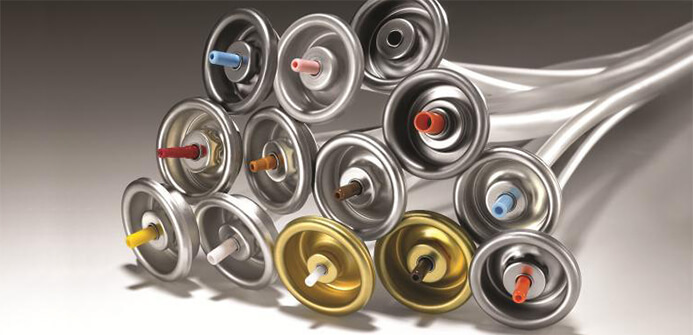
The aerosol valve can reliably and effectively spray out the aerosol content, but also has good sealing performance in the closed state, so that the aerosol content does not leak out.
At the same time, the aerosol valve has to withstand the erosion of various formulations and adapt to the high speed and high pressure filling performance of the production line.
In addition, the aerosol valve should have a certain degree of firmness and strength to withstand the high pressure in the can.
Therefore, the quality of the components of the aerosol valve and the control of the fit between the components is crucial.
We’are going to talk about the aerosol valves with the following 3 topics. If you want to have a sort of deep comprehension of aerosol valves within a short time, you’ll love this post.
Let’s get started.
Topic #1: Types of Valves & Scope of Application
1. Classification of Aerosol Valve Types
In order to meet the needs of the market and users, the variety of valves has gradually diversified from a single to a diversified.
In fact, it has been difficult to clearly define the types of valves because many of the structures, features, and functions of valves are referenced and overlap with one another.
The breakdown is as follows.
1) Classification by Mode of Use
This classification includes upright valves (including positive pressure and oblique push valves), inverted valves and 360° valves.
2) Classification by Continuous Spray Method
Dosing valve: With each press of the actuator, the aerosol can release the contents in a quantitative manner according to the design requirements.
Continuous valve: Pressing the actuator releases the contents continuously.
Full release valve: A single actuator will release all contents of the aerosol (mainly for indoor pesticides).
3) Classification by Basic Valve Structure
This classification includes both male and female valves.
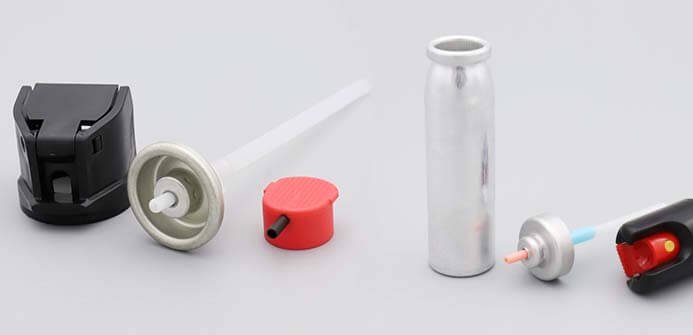
4) Classification by Design and Production Company
At present, the valves used are mainly from three international companies: Precision series, LINDAL series, COSTER series.
And seen from the industrial structure, the three companies are moving to “environmental protection, technology, personalized” diversification.
5) Classification by Valve Seal Cup Size
These can be divided into the most common one-inch valves and 20 mm valves, as well as special 13 mm valves.
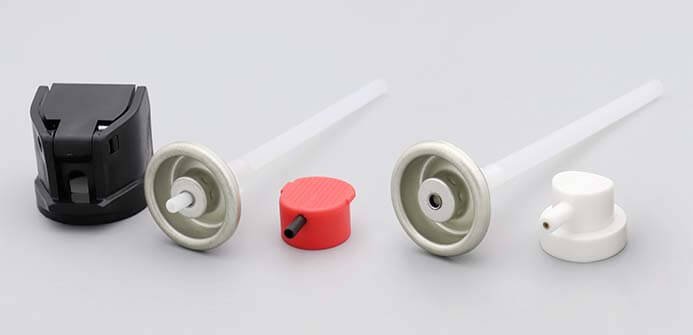
2. Application Scope of Various Aerosol Valves
Each type of valve has a different use and filling method, so each one has the corresponding scope of application.
1) Upright Type Valves
Suitable for: Stem fixed, mounting cup fixed and can fixed push actuator
Applications: household goods, pesticides, automotive goods, industrial goods, personal care products
2) Inverted Type Valves
Suitable for: mounting cup fixed type inverted push actuator
Applications: hair mousse, road marking, carpet shampoo, dust mite killer
3) 360° Valves
Categories: steel ball type and mallet type
Principle: The steel ball type clogs the suction tube in the valve chamber when inverted, thus allowing spraying both upright and inverted.
The mallet type is a heavy hammer added to the liquid inlet at the end of the tube. The aerosol in the process of use due to the gravity of the hammer causes the tube to follow the direction of use to ensure that the tube is submerged in the liquid phase.
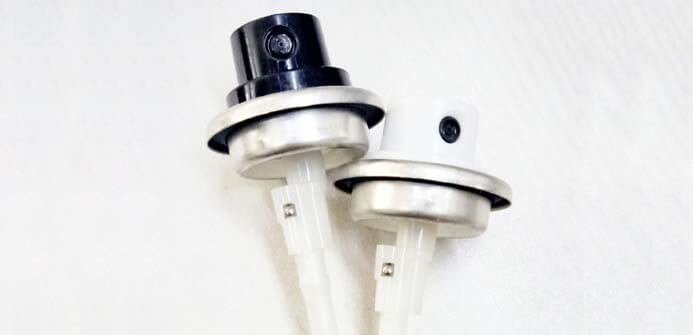
Application characteristics:
360° steel ball valves are mainly used in aerosols in which LPG and DME are the main propellants.
360° mallet type valves are mainly applied in aerosols in which compressed air, nitrogen and carbon dioxide are the main propellants because such aerosols are characterized by low propellant filling volume, high pressure in the can and poor compatibility between the propellant and the contents, while 360 steel ball-type valves sealed with steel beads are prone to poor sealing and leakage resulting in aerosol failure.
Applications: automotive cleaners, CO2 based aerosols, road markers, lubricants, garden insecticides, nitrogen-based aerosols, etc.
4) Powder Valves
Principle: Longer pressing stroke and reduced inner gasket size are conducive to scraping away the powder on the valve stem and preventing powder clogging
Applications: antiperspirants, therapeutic powder products, gap detectors.
5) Slant Thrust Valves
Oblique thrust type valves are suitable for spraying a horizontal surface.
Applications: ironing, pre-washing
6) Viscous Product Valves
Conventional PU valve, single piece stem + chamber with large bore design
Applications: polyurethane foam, caulking, cheese, cream toppings, cake pastry
7) Metered Dosing Valves
Principle: The volume of the valve is fixed by the special design of the valve stem and the size of the valve chamber to control the volume of spraying each time as the valve is pressed.
Applications: inhalers, air fresheners, pesticides, aromatherapy.

8) Bag on Valves
Advantages:
a) Compressed air or nitrogen replaces the flammable and explosive gases such as Freon, propane, butane and other flammable and explosive gases as the driving gas, eliminating the pollution of the atmospheric environment and the interference of the above gases on the fidelity and purity of aerosols.
The use of compressed air or nitrogen completely eliminates the hidden danger of using flammable and explosive gases in the production process of aerosol products, providing a practical means for the development of environmentally friendly aerosol products.
b) The contents of the composite bag do not come into contact with the aerosol can, preventing the corrosion of the aerosol can, extending and strengthening the validity and sealing of aerosol products, which is beneficial to the diversification of aerosol products raw material selection (unlimited to acid and alkali), opening up an approach for the application of aerosol technology in other industrial products.
c) The aseptic treatment of composite bags provides a reliable hygiene guarantee for food, medicine and other aspects of aerosol products.
Applications: water-based fire extinguishing agent, hairspray, air freshener, insecticide, seawater nasal spray, disinfectant (human body, environment), female rinse (lubricating) agent, external medicine (scald, contusion) aerosol, laxative, paint (coating), industrial aerosol such as mold release, detection, security aerosol, food flavoring, coloring, painting and other aerosols.
9) Female Valves
The female valve differs from the male valve by the difference in stem construction. The female valve retains only half of the stem and the other half of the stem is on the actuator. The specificity of the structure makes it outstanding in the dispersion and filling speed of the product.
The actuator is integrated with the stem and can be removed for cleaning or replacement, effectively solving the problem of plugged stem and actuator. It can be used for most aerosol products, especially high viscosity products such as spray adhesives, auto-painting, etc.
This valve, when used in conjunction with a fan shape nozzle, will give the product more personality, convenience and practicality.
Topic #2: Structure of the Valve
1. Basic Structure of the Valve
Conventional valve construction consists of the following components: actuator, insert, stem, mounting cup, spring, mounting cup gasket, stem gasket, housing, spring and dip tube.
Some special cases, such as for cost control, or for spraying special needs such as snow, ribbon, etc., may have valves that do not include a insert.
In addition, valves for inverted products such as mousse products and lighter gas will not use the dip tube. And in the current market, more and more products are using over-cap actuators instead of conventional actuators.
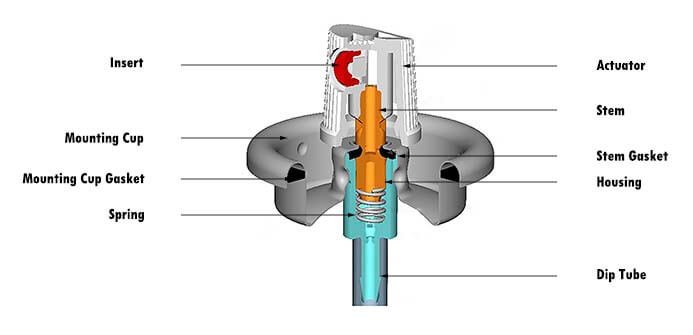
2. The Role of Each Valve Component
1) Valve Stem
The stem is the part used to connect the valve to the actuator and the size of its outer diameter affects the degree of tightness of the fit with the actuator.
If the fit is too tight, the contact of the actuator will easily expand and crack; if the fit is too loose, it will easily leak when used. The inner diameter of the valve stem and the size of the metering hole will affect the aerosol flow, spray rate and filling speed.
2) Housing
The valve housing is the component that connects the stem, stem gasket, mounting cap, spring, and dip tube.
It mainly plays a role in the aerosol valve to withstand spring force and the power of gas-liquid flow.
The size of the tail hole and side hole of the valve housing affects the spraying rate and atomization particle size.
3) Spring
The aerosol valve spring mainly restores the valve stem to the sealed position.
Obviously, the spring must have a certain strength and rigidity, and the spring wire is required to be stainless steel, otherwise it cannot withstand the erosion of the contents and use requirements.
Spring pressure directly affects the feel and stem restoration when pressed. Too low pressure will affect the restoration of the valve stem, can not close the aerosol valve in time, resulting in leakage; too high pressure will make the aerosol valve press poor feel and filling speed is reduced.
4) Stem Gasket
The stem gasket is a critical component of the aerosol valve, and its role is to maintain a good air-tightness in the spray, effectively preventing leakage of the contents of the aerosol can.
The seal of the stem gasket includes a static seal when the product is placed in a static position and a dynamic seal when the product is used.
There are three main materials of stem gasket: sodium buna, nitrile rubber and butyl rubber.
5) Mounting Cup Gasket
Classification: glued; cut; set; and laminated.
Main roles:
a) The mounting cup gasket is also called outer gasket. It mainly plays a good static sealing role between the aerosol valve and the aerosol can lid, so that the aerosol is stored for a long time in different environments and temperatures without producing a lot of leakage and loss.
b) Act as a buffer in the sealing process. The laminate type outer gasket can separate the mounting cup from the contents, thus ensuring that the mounting cup is not corroded.

Cut Type Gasket:
Available materials include sodium buna, neoprene and fluoroelastomer. This type of gasket is mainly suitable for aluminum aerosol and hand-fed valves. It is used extensively in Europe and Germany, but to a lesser extent in the United States.
When this outer gasket is used on the aerosol filling line, due to the vibration generated by the machine feeding valve, it will cause the outer gasket to fall off from the mounting cup, or the outer gasket displacement leads to the outer gasket convex adhesive after sealing the can (the ratio is about 1%). This problem can cause severe aerosol leaks, leading to product scrapping.
Glue Type Gasket:
This type of seal material is sensitive to temperature and solvents, and are prone to seepage or extrusion during the crimping and gas filling process.
The material injection paste emits formaldehyde during the vulcanization process, which is harmful to the human body, and can corrode the rolled edges of aluminum cans, so it is not used much now.
Set Type Gasket:
The main material used is polypropylene or polyethylene, the thickness of which ranges from 0.32 to 0.36 mm.
Advantages: a) low cost; b) no EPA effect from other seals; c) higher dimensional accuracy than other types of seals; d) lowest bending leakage among highly reactive solvent products; e) no seal drops; f) avoids potential leakage.
Laminated Type Gasket:
Laminate with a stack of laminates directly on the side of the valve mounting cup in contact with the can mouth. When sealing the lid to the can, the creep of this laminated layer is used to fill the gap between the lid and the metal surface of the can to achieve sealing.
The main materials are polyethylene or PET, which does not allow bacteria and mould to grow, is non-toxic, odourless, colourfast and solvent resistant, and can be used in food and medicine.
This type of valve is also very good to avoid the potential risk of external gasket fall, suitable for chemically polarized solutions, but the crimping dimmension and can mouth requirements are high.
6) Mounting Cup
The mounting cup is the base of the aerosol valve, which connects the aerosol valve to the aerosol can to seal, while the stem, stem gasket and spring are assembled by clamping the valve housing.
7) Dip Tube
The main function of the aerosol valve dip tube is to transport the liquid ejected material in the container under pressure into the valve body cavity.
Not all aerosol valves require a drain tube. For example, butane gas valves and mousse valves are used in reverse, the dip tube can be eliminated.
However, in order to mechanize the production of aerosols so that the machine can put the valve accurately into the aerosol can, sometimes the mousse valve also adds a dip tube. The main types are: standard, coarse and capillary.
8) Actuator
The actuator is an indispensable and critical part of commonly used aerosol valves.
Generally, actuators are equipped with inserts, i.e. micro-atomizer structures, to jointly complete the regulation of various spray properties of aerosol products such as: release rate, particle diameter, spray angle and spray distance.
The structure, product quality and assembly quality of the micro-atomizer play a vital role in the atomization effect of the aerosol product.
The main types of actuators are: mechanical breakup, non-mechanical breakup, single piece, double piece, mousse actuator and shaving foam actuator.
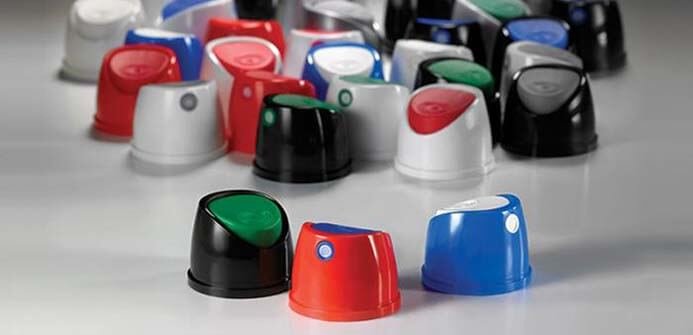
As formulations change, the technology of each valve fitting will become increasingly important. In the future aerosol system development, insert design and technology will play an extremely important role in the use and diversification of structures.
Topic #3: Several Major Factors to Consider for Valve Selecting and Product Quality
Valves as an important part of the aerosol packaging, assume the connection of the can, withstand the pressure inside the can, maintain static sealing, keep the channel smooth and so on, we should choose the valve from many aspects, multiple perspectives to consider its suitability.
Depending on the characteristics of the aerosol product, the following aspects should be highlighted when selecting a valve.
1. Safety of the Valve
See if the valve used can withstand the pressure required by the product, if the valve matches the chemical solvent in the product, how strong the chemical solvent in the product will corrode the valve mounting cup, etc.
2. Effect of the Valve on the Spouting of the Product
Some aerosols such as insecticides have special requirements for atomization particle size, therefore it is necessary to consider the shape of atomization, the size of the particle, the spray angle, spray range, etc.
3. Whether the Valve Is Compatible with the Production Process of the Company
Due to differences in valve systems and filling equipment, there can be problems with the fit between valves and equipment. For example, between the filling method of TTV(Through The Valve) and UTC(Under The Cup), there are significant differences in both valve size and valve construction.
4. Valve Price
On the premise of being able to use lower-priced valves to meet the demand, there is no need to choose a higher grade, which is conducive to the price advantage of aerosols in the market.
5. Use Habits of Aerosol Products
Each aerosol has a different way of use, so choose the right valve according to the customer’s use habbits. Due to the variability of aerosol valve manufacturers, there are also differences in products.
The valves currently used by many companies are mainly from three companies, Precision (USA), COSTER (Italy) and Lindal (Germany).
Over 90% of the valves used in North America are supplied by Precision. The Italian Coster valve is in excellent spray condition, with fine mist particles, good feel and no clogging, and the company also offers a variety of lines for aerosol production. Lindal Germany has a wide range of valve types.
6. Special Requirements for Aerosol Valves
Aerosols are flammable and explosive hazardous substances. The key to whether it is safe and effective for the user is whether the valve can meet the safety standards.
7. Pressure Resistance of Aerosol Valves
The pressure of the aerosol is mainly derived from the pressure of the propellant in the can. The general pressure at 23°C is about 0.5 MPa. But with increasing temperature, the pressure in the can will increase. The pressure of propellants such as LPG and DME varies greatly with temperature.
The mounting cup is the most important component to withstand the pressure applied to the aerosol valve. The industry usually uses 0.27 mm thick tinplate or 0.42 mm thick aluminum for stamping.
If the valve is required to withstand a pressure of about 2.0 MPa, used in fire extinguishers and other high pressure products, it is necessary to choose thicker materials to increase its pressure resistance. 0.42 mm thick tinplate can be used as the mounting cup material.
8. Sealability of Aerosol Valves
The seal is assembled in the valve body, called the inner gasket, which forms a complex sealing relationship between the valve body, the mounting cup, and the stem.
Unlike the outer gasket, this is a dynamic sealing point and is in direct contact with the solvent in the can. This is the most common and major sealing point for aerosol valve leaks, so the seal on the production of aerosol valves is of the highest priority.
9. Corrosion Resistance of Aerosol Valves
The inner surface of the aerosol valve is in direct contact with the contents of the aerosol. If the product formulation is not well controlled in terms of corrosion resistance, there is the potential for corrosion of various aerosol valve components.
In water-based formulations, for example, if the mounting cups are produced with unsurfaced tinplate, they are susceptible to corrosion spots and subsequent perforation leaks. In this case, either a tinplate or an aluminium mounting cup with an inner coating should be used.
It is also worth mentioning that there are very certain formulations that can corrode or dissolve the valve body, mainly because the product solution contains components that decompose the valve body plastic.
Currently, the materials used in the production of valve bodies are usually polyethylene (PE), paraformaldehyde (POM) and nylon (PA). Therefore, when selecting an aerosol valve, it is also important to pay attention to the suitability of the material used to produce the valve body to the product formulation.
Recent Posts
-
2 Ways You Can Take to Avoid Aerosol Can Corrosion Leaks
 After many years of scientific research, it has been found that HFCs, which used to be used as aerosol propellants, have a certain destructive effect on the ozone layer, so the production of CFCs in Europe and the United States is restricted by law.
After many years of scientific research, it has been found that HFCs, which used to be used as aerosol propellants, have a certain destructive effect on the ozone layer, so the production of CFCs in Europe and the United States is restricted by law. -
23 Aerosol Propellant Losses Will Cost You Money and Ruin Your Plant
 Did you know that aerosol propellants can be lost in 23 places? It is not only the propellant gas and money that are lost, but also the possibility of destroying the plant. Since there is almost no way to monitor and measure the use of propellants, it is very easy to lose them
Did you know that aerosol propellants can be lost in 23 places? It is not only the propellant gas and money that are lost, but also the possibility of destroying the plant. Since there is almost no way to monitor and measure the use of propellants, it is very easy to lose them -
8 Advantages to Use Nitrogen(N2) as Aerosol Propellant Gas
 70 years after the birth of the aerosol industry, a new propellant was discovered - nitrogen and pure compressed air containing 78% nitrogen. These gases have been known for centuries. But until then, they had not been seriously considered because of two major drawbacks: the majority of the gas escapes when sprayed obliquely or
70 years after the birth of the aerosol industry, a new propellant was discovered - nitrogen and pure compressed air containing 78% nitrogen. These gases have been known for centuries. But until then, they had not been seriously considered because of two major drawbacks: the majority of the gas escapes when sprayed obliquely or
Maximize Your ROI
by Investing in Our Cost-Effective Aerosol Filling Machines.
Contact Us
Copyright© 2019 Dawsom Mechanical & Electrical Co., Ltd. All Rights Reserved.



